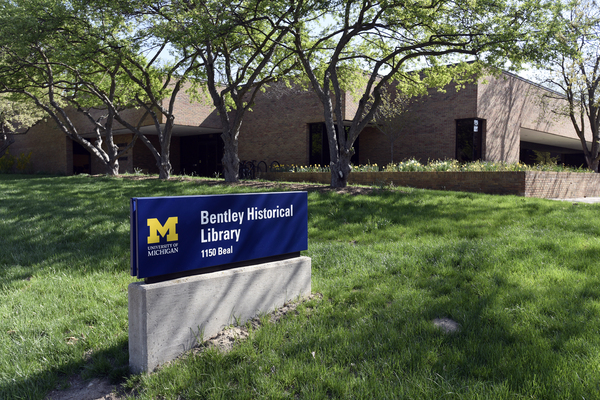Search Results
Correspondence Files, 1900-1959
The CORRESPONDENCE series (11 linear feet, 1900-1903, 1929-1959) is arranged in four subseries: Correspondence, 1900-1903, 1929-1943; Director's Correspondence, 1946-1951; Editor's Correspondence, 1946-1951; and Director of University Relations Correspondence, 1950-1959. Most correspondence is with newspapers, magazine publishers, other universities, and radio and television broadcasting firms and associations.
The earliest correspondence, 1900-1903, includes letters written to Ralph Ellsworth relating to inquiries asking other universities about their information dissemination activities. Correspondence from 1929 to 1943 is chronologically arranged material sent and received by Roger Morrisey and Wilfred B. Shaw and reflects some of the alumni information activities once handled by the office as well as contact with press agencies and newspapers throughout Michigan and the nation
Director's Correspondence, 1946-1951, and Editor's Correspondence, 1946-1951, are similar in content. These two alphabetically arranged subseries comprise the correspondence of Arthur L. Brandon and Cleland B. Wyllie along with some other staff members. Wyllie served as editor but also handled other responsibilities within the office.
The most substantial subseries is the Director of University Relations Correspondence, 1950-1959, arranged alphabetically by topic. It is primarily the correspondence of Arthur L. Brandon. Topics include academic freedom and anti-communism activities (filed under "subversive activities"), the 250th anniversary of Detroit's founding, Harlan Hatcher's inauguration as president, controversy surrounding the renaming of Michigan State University, atomic research sponsored by the Phoenix Project, the 1955 Salk Polio vaccine testing and announcement, and radio and television broadcasting. General information on university activities and programs appears throughout the files, which also include scattered press releases, articles, and clippings in addition to the correspondence. Newspapers and magazines doing stories on the university, such as Life, are well represented within this subseries.
Council for International Living. (University of Michigan) records, 1949-1966
0.5 linear feet
The records of the Council for International Living at the University of Michigan encompass the years 1949-1966. They are divided into four series: Topical, Houses, Photographs, and Printed Works.
The Topical series (six folders) is arranged alphabetically and includes background materials, bylaws, clippings, financial records, and minutes of board of trustee meetings. The folders, for the most part, contain only scattered records. The minutes are the most valuable for charting activities of the Council. For researching student life in the residence houses, the Houses series (8 folders) includes background information, financial records, house policies, and minutes from house meetings. It is arranged alphabetically by house name, and like the topical series, its files are quite incomplete. The Photographs series (one folder) consists of one 8X10 black and white print (undated and unidentified) of a group of international students. Finally, the Printed Works series (4 folders) includes various annual reports, constitutions, manuals, and newsletters.
Creighton R. Coleman Papers, 1941-1977
2.3 linear feet
The collection is arranged into the following series: Office of the Military Government for Germany (US) Economics Division, Decartelization Branch; State Senator's Files; Topical Files; and Photographs.
C. Theodore Larson papers, 1930-1985 (majority within 1951-1974)
4 linear feet (in 5 boxes)
The papers of C. Theodore Larson measure 4.0 linear feet and date from 1930 to 1985. The bulk of materials, however, are from 1951 to 1974. The papers contain five series: Architectural Research; College of Architecture and Urban Planning; Correspondence; Development index and Published materials.
Current Topic Club (Owosso, Mich.) Records, 1894-1998
1.5 linear feet (in 2 boxes)
The Current Topic Club records, 1894-1975 consist of 1.5 linear feet in two boxes and are organized divided into three series: Administrative Records, Photographs and Programs.
The Administrative records series includes files on the club's Constitution and Bylaws, Minutes and Correspondence. The Correspondence consists of only a few items, such as thank-you notes. The Minutes are contained in bound books, each book covering a number of years. There are only two gaps in their coverage, October 1898-April 1901, and April 1920-May 1925. The programs series includes copies of all yearly printed programs from 1897 through the 1974-1975 club year. Photographs consist of three group portraits of the Current Topic Club membership made in August 1924, summer(?) 1944--their 50th Anniversary, and May 1973. Each is labeled.
The records of the Current Topic Club are an important source of information for the researcher studying women's activities and interests, because they cover an extended time span in a well-documented manner. The records represent a significant addition to the history of women in Michigan, and also throw light on an important period in the growth of a typical mid-western city.
There were occasions when men were invited to address the group. An important example here was the appearance of Raoul Wallenberg, a student from Sweden who had just graduated from the University of Michigan College of Architecture, and delayed his return home in order to speak to the club at the invitation of Mrs. L. L. Woodard. The minutes for February 18, 1935 record that he discussed the geography and history of Sweden, described Swedish architecture and passed around sketches illustrating his points.
Musical programs and member-prepared skits were a feature of some meetings. They were interested in political events of the day and often signed petitions on pending legislative action, e.g., school taxes, child labor, county agricultural extension service, and state aid to libraries.
In the 1949-1950 club year the members devoted all meetings to women and the women's movement for the first time, and continued this theme in 1950-1951. In earlier years one meeting each year centered around a famous woman.
Cveta Popovich photographs, circa 1930-1950
1 folder
This collection is comprised of black-and-white photographs of murals and other paintings executed by Popovich.
